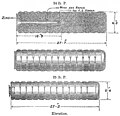| Ordnance BL 6-inch 80-pounder Mk I | |
|---|---|
 Gun from HMAS Protector at Birkenhead, South Australia, August 2011 | |
| Type | Naval gun Coast defence gun |
| Place of origin | United Kingdom |
| Service history | |
| In service | 1880–1943 |
| Used by | Royal Navy Australian Colonies |
| Production history | |
| Designer | Elswick Ordnance Company |
| Manufacturer | Elswick Ordnance Company |
| Variants | Mk I |
| Specifications | |
| Mass | 80 or 81 cwt (4 tons) [1] |
| Barrel length | 153 – 156 inches [2] |
| Shell | 80 pounds (36.29 kg) Palliser, Shrapnel, common |
| Calibre | 6-inch (152.4 mm) |
| Breech | 3 motion interrupted screw. Elswick cup obturation |
| Muzzle velocity | 1,880 feet per second (573 m/s) [3] |
| Maximum firing range | 8,000 yards (7,300 m) |
The BL 6-inch 80-pounder gun Mk I was the first generation of British 6-inch breechloading naval gun after it switched from muzzle-loaders in 1880. They were originally designed to use the old gunpowder propellants.



